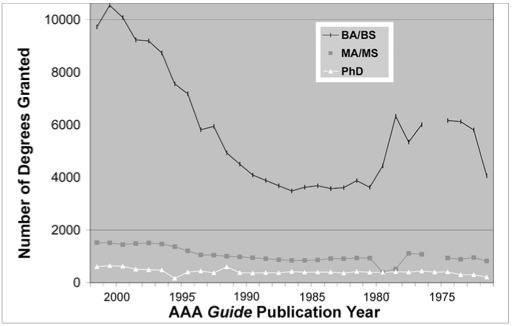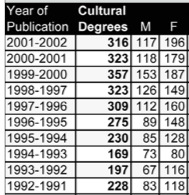This is old news for those of you who read Anthropology News regularly, but a recent AAA report [PDF] by Salvadore Boites, Thomas Patterson, and Pamela Geller entitled
“The Growth and Changing Composition of Anthropology 1966–2002” summarizes shifts in the number of degrees awarded and the gender and subspecialty breakdowns for PhD dissertations published during those years, and includes two tables for comparison.
The results are interesting. I don’t know why the AN chart puts the years going in the “wrong” direction, but you can see that while there has been little change in the number of Ph.D.s, there has been astronomical growth in the number of B.A. degrees in Anthropology.

Here is some detail regarding the number of Ph.D.s in Cultural Anthropology in the 90s.

Read the full report [PDF], or the AN article (AAA membership required), for more details.
Kerim,
I don’t exactly know how to put this diplomatically but as a vaguely innumerate social scientist with a hard core math casse of maths envy, it does strike me that your analysis:
“The results are interesting… that while there has been little change in the number of Ph.D.s, there has been astronomical growth in the number of B.A. degrees in Anthropology”
… is worse than misleading. Obviously you were going with the aesthetic fact that the line for total PhDs awarded only wobbles a bit up over the years (What happened in 1995!?!), but if you think about the numbers for a moment, much less the economies of scale involved surely you would agree that the growth of the anthro PhD market from 50 or so a year in 1975 (you don’t give the number) to 316 isn’t merely significant. Ginourmous is a more analytically adequate term. Meanwhile, while we might quible whether the positive change from 1991-1992 to 2001-2002, 228 to 316, is merely enormous or also deserves some sort of heightened language to capture the sound of a pontential market glut, again the merely modest scholarly term in statistics would likely be… “significant”. Indeed, with respect to the number of professors necessary to illuminate the anthro student lightbulb, the BA graph and its promise of disciplinary hope may too be at least partially visual and chimerical.
For instance, if someone took a third of your salary/grant/fellowship away, you’d be rather sour faced I imagine, or if they added same, rather ebullient. Unless, perhaps, you’re a model of stoicism and otherwordly comportment, mental equipoise & cetera.
In any event, it looks like our field is expanding in all dimensions and the question is one of evaluating the variable rates of expansion.
Best statistical wishes and all that.
I agree I may be innumerate, but there were 269 Cultural Ph.D.s in 1975. Not 50. 58 was the number of degrees in Biology. And there were 313 Cultural Ph.D.s in 1976.
I don’t see a big difference between 313 and 316.
Now it is true that there was a big growth in the 60s and early 70s, as there was in the number of BAs. But then there was also a huge growth in the entire university system in the US at that time. It is because of this that I don’t make much of the earlier growth, although I don’t have the data to fine-tune how anthropology might related to this larger growth or that of other fields.
I was fairly timid about making any conclusions from these numbers, but if I was pressed I would say that the only reason there hasn’t been an equal surge in the number of anthropolgy jobs is because of the increased reliance on adjunct and part-time faculty – not because of lack of demand.
It is at least mildly humorous, if not patently hilarious that I fell victim to the same error of visual calibration between the data pt. at 1975 and at 2000 that I queried the initial posting on, with respect to reading the graph for 1975 (of course, I started by noting that I myself was vaguely innumerate, and the fact that the pt. at 75 looking quite a bit lower than that at 2000 being, yes, subjective, it now seems being quite to the point). but the line ‘there has been little change in the number of PhDs’ awarded still rankles even with your more-than-appropriate taking me to task for not consulting the details of the original article which you kindly provided. Perhaps we just read the numbers differently, but while there are some startling and curious short term spikes and valleys (or so I read them) in annual graduation rates which yield relatively largely equivalent by-decade medians, taken from year to year, the overall trend yields an annual median increase which strikes me as especially significant when you think about these numbers in terms of practicing once-occurrent individuals out there in their research fields all clamoring for sub-discipline specifiic jobs, publications & cetera. Perhaps, more interestingly, this trend (if there is one) could be considered in terms of its impact on the primary intellectual knowledge work of practitioners from the previously relatively isolated romantic-ish fieldworkers to those of us now engaged in various scholarly networks bearing on the research itself and not merely its dissemination. Something else to look at, I suppose, would be the annual total of living, breathing, practicing AAA card-carrying anthropologists. My guess is that that number too has going up over the years. Perhaps dramatically. Perhaps not. It’s an empire(ical) question, right. Of course those folks come from somewhere…
Thanks, by the bye, for your response.